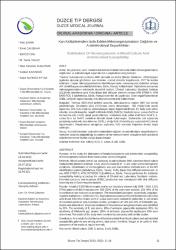| dc.contributor.author | Şahin, İdris | |
| dc.contributor.author | Çalışkan, Emel | |
| dc.contributor.author | Öztürk, Elif Cihadiye | |
| dc.contributor.author | Yavuz, Mehmet Tevfik | |
| dc.contributor.author | Albayrak, Hilal Türkmen | |
| dc.contributor.author | Karadağ, Gülkan | |
| dc.contributor.author | Altınöz Aytar, Asiye | |
| dc.date.accessioned | 2019-10-25T08:57:25Z | |
| dc.date.available | 2019-10-25T08:57:25Z | |
| dc.date.issued | 2013 | en_US |
| dc.identifier.issn | 1307671X | |
| dc.identifier.uri | https://hdl.handle.net/20.500.12462/9276 | |
| dc.description | Yavuz, Mehmet Tevfik (Balikesir Author) | en_US |
| dc.description.abstract | Purpose: In this study, the distribution of hospitalized patients and antimicrobial susceptibility of microorganisms isolated from blood culture were investigated. Methods: Blood samples sent to our laboratory by taking Bactec 9050 automated blood culture media bottles (Becton Dickinson, USA) were incubated at 35 ° C and under normal atmospheric conditions. Identification of microorganisms was used conventional methods and / or the API identification systems (bioMérieux, Etoile, Fransa). Kirby-Bauer Disk diffusion method and / or was ATB STREP 5, ATB ENTEROC 5 (bioMérieux, Etoile, Fransa) performed for antibiotic susceptibility testing according the criteria of Clinical and Laboratory Standards Institute. Extended-spectrum beta-lactamase (ESBL) production was investigated with disk diffusion screening test in Gram-negative bacteria. Results: A total of 2,807 blood samples sent to our laboratory between July 2009 - 2010. 2,121 (75%) patients of didn't reproductive, 583 (21%) of the cases were positive, 103 (4%) of the contamination was evaluated as an example. The most isolated pathogens, respectively, coagulasenegative staphylococci (CNS) (42.1%), Staphylococcus aureus (22%) and Escherichia coli (13%) were found. 54% KNS strains, 44 % S. aureus strains were resistant to methicillin. E. coli strains of extended-spectrum beta-lactamase (ESBL) prevalence of 14% and 21 % of Klebsiella spp. strains were determined. Imipenem resistance in Pseudomonas aeruginosa strains were identified by 39%. The sensitivity of E. coli strains, 93% of amikacin, piperacillin-tazobactam 95%, the sensitivity of Klebsiella spp. strains, 100% of amikacin, piperacillin-tazobactam 93% were determined. The results of the study were examined by comparing with similar studies. Conclusion: As a result, the distribution of bacteria isolated from blood cultures and antimicrobial susceptibility patterns vary among centers, each center, therefore, thought to be useful in their assessment of the results at regular intervals. | en_US |
| dc.description.abstract | Amaç: Bu çalışmada, yatan hastaların kan kültürü örneklerinden izole edilen mikroorganizmaların
dağılımının ve antimikrobiyal duyarlılıklarının araştırılması amaçlanmıştır.
Yöntem: Laboratuarımıza Bactec 9050 otomatik kan kültür (Becton Dickinson, USA) besiyeri
şişelerine alınarak gönderilen kan örnekleri, normal atmosfer koşullarında, 35°C’de inkübe
edilmiştir. Üreyen mikroorganizmaların identifikasyonunda, konvansiyonel yöntemler ve/veya
APİ identifikasyon sistemleri(bioMérieux, Etoile, Fransa) kullanılmıştır. Tiplendirme sonrasında
mikroorganizmaların antibiyotik duyarlılık testleri, Clinical Laboratory Standards Institute
(CLSI)'nin önerilerine göre Kirby-Bauer disk difüzyon yöntemi ve/veya ATB STREP 5, ATB
ENTEROC 5 (bioMérieux, Etoile, Fransa) sistemleri ile yapılmıştır. Gram negatif bakterilerde
GSBL varlığının saptanmasında, disk difüzyon tarama testi kullanılmıştır.
Bulgular: Temmuz 2009-2010 tarihleri arasında, laboratuarımıza toplam 2807 kan örneği
gönderilmiştir. Örneklerin 2121 (%75)’inde üreme olmamışken, 583 (%21)’ünde üreme
saptanmış, 103 (%4) örnek ise kontaminasyon olarak değerlendirilmiştir. En fazla izole edilen
etkenler, sırasıyla koagülaz negatif stafilokok (KNS) (%42,1), Staphylococcus aureus (%22) ve
Escherichia coli ( %13) olarak tespit edilmiştir. Kültürlerde izole edilen KNS’lerin % 54’ü, S.
aureus’ların ise %44’ü metisiline dirençli olarak bulunmuştur. Escherichia coli suşlarında
genişlemiş spektrumlu beta-laktamaz (GSBL) sıklığı %14, Klebsiella spp. suşlarında %21 olarak
saptanmışken, Pseudomonas aeruginosa suşlarında %39 oranında imipenem direnci tespit
edilmiştir.
Sonuç: Kan kültürlerinden izole edilen bakterilerin dağılımı ve antimikrobiyal duyarlılıklarının
merkezler arasında değişebildiği, bu nedenle de her merkezin kendi sonuçlarını belli aralıklarla
değerlendirmesinin faydalı olacağı düşünülmüştür. | en_US |
| dc.language.iso | eng | en_US |
| dc.rights | info:eu-repo/semantics/openAccess | en_US |
| dc.subject | Blood Culture | en_US |
| dc.subject | CNS | en_US |
| dc.subject | ESBL | en_US |
| dc.subject | S. aureus | en_US |
| dc.subject | Kan Kültürü | en_US |
| dc.subject | KNS | en_US |
| dc.subject | S. Aureus | en_US |
| dc.subject | E.Coli | en_US |
| dc.subject | GSBL | en_US |
| dc.title | Distribution of microorganisms in blood culture and antimicrobial susceptibility | en_US |
| dc.title.alternative | Kan kültürlerinden i̇zole edilen mikroorganizmaların dağılımı ve antimikrobiyal duyarlılıkları | en_US |
| dc.type | article | en_US |
| dc.relation.journal | Düzce Medical Journal | en_US |
| dc.contributor.department | Tıp Fakültesi | en_US |
| dc.identifier.volume | 15 | en_US |
| dc.identifier.issue | 2 | en_US |
| dc.identifier.startpage | 11 | en_US |
| dc.identifier.endpage | 14 | en_US |
| dc.relation.publicationcategory | Makale - Ulusal Hakemli Dergi - Kurum Öğretim Elemanı | en_US |


















